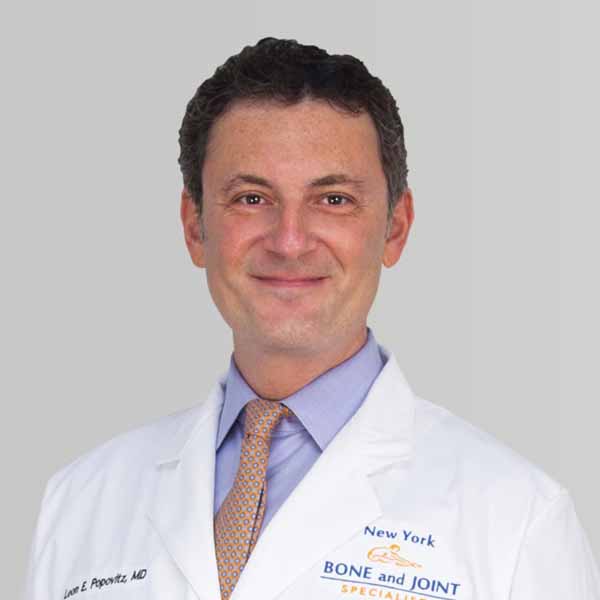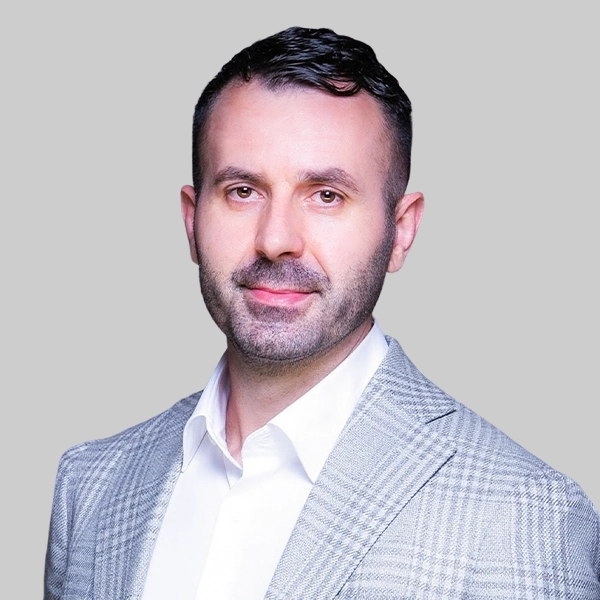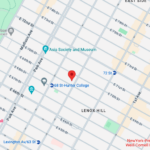Did you hear a loud “pop” during sports activity followed by immediate knee pain and swelling?
You may have suffered an ACL tear, one of the most serious and common knee injuries affecting athletes and active individuals. With 100,000 to 200,000 ACL injuries occurring annually in the United States, this injury can sideline even the most dedicated athletes for months.
At New York Bone & Joint Specialists, our fellowship-trained knee surgeons have decades of experience treating ACL tears with both surgical and non-surgical approaches. We understand the urgency of getting you back to your sport and active lifestyle. Whether you’re a weekend warrior playing pickup basketball in Central Park or a competitive athlete, our expert team will create a personalized treatment plan to restore your knee’s stability and function.
Time is critical with ACL injuries. Early diagnosis and proper treatment significantly impact your recovery timeline and long-term knee health. Don’t let an ACL tear end your athletic career—our proven treatment protocols have helped thousands of New Yorkers return to peak performance.
What is an ACL Tear?
The anterior cruciate ligament (ACL) is one of four major ligaments that stabilize your knee joint. Located in the center of the knee, the ACL crosses with the posterior cruciate ligament (PCL) to form an “X” shape that controls the knee’s rotational stability.
The ACL’s job is to prevent the tibia from moving in front of the thighbone as well as stopping the knee from rotating too far.
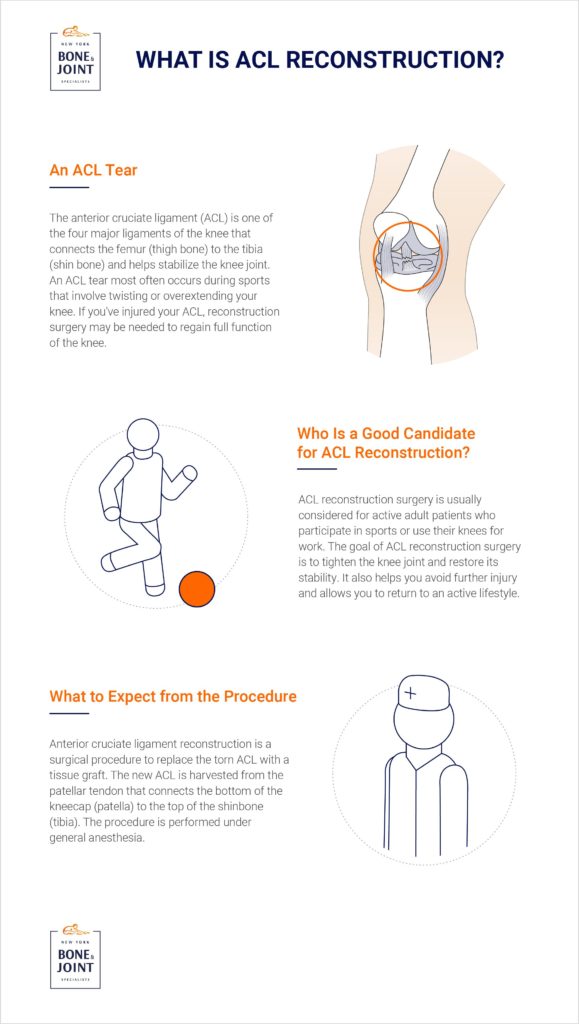
The ACL’s Critical Functions:
- Prevents forward sliding of the tibia (shinbone) relative to the femur (thighbone)
- Controls rotational movements during cutting and pivoting motions
- Maintains overall knee stability during athletic activities
- Protects other knee structures from excessive stress
However, its position makes it vulnerable to injuries such as a tear or sprain. Damage to the ACL accounts for nearly half of all knee injuries.
ACL injuries are classified into three categories:
- Grade 1: The ACL is stretched, but remains intact. This is classified as a sprain.
- Grade 2: A partial tear.
- Grade 3: A complete tear of the ACL, leaving it in two pieces. This is the most common type of tear.
Tears are often the result of:
- Sudden direction changes while running
- Landing incorrectly from jumps
- Direct contact to the knee during sports
- Pivoting movements with the foot planted
- Deceleration and stopping motions
ACL Tear Symptoms: Recognizing the Signs
ACL tear symptoms are pronounced and occur at the same time as the injury. Look for these signs of an ACL tear:
- A loud popping sound as the ligament ruptures.
- Severe pain.
- Rapid swelling.
- Pain when putting weight on the knee.
- A feeling of instability in the knee; the knee “buckles.”
“An ACL tear doesn’t mean the end of your athletic pursuits – with today’s advanced reconstruction techniques and rehabilitation protocols, most patients return to their previous activity levels. We work closely with you to develop a recovery plan that gets you back to peak performance safely and effectively.” – Dr. Leon Popovitz, MD, New York Bone & Joint Co-Founder.
What Does an ACL Tear Feel Like?
If you’ve suffered a complete ACL tear, it will most likely feel like:
- You’ll hear a loud popping sound in the knee, or experience a “snapping” sensation in the knee.
- Your knee will immediately swell.
- You’ll feel severe pain.
- Your knee gives out when you try to walk.
If you’ve suffered a partial ACL tear, you may not experience any significant symptoms immediately. Yet continuing to stay active with a partial ACL will worsen the symptoms of instability and pain.
ACL tears can often be mistaken for a meniscus tear, another common knee injury. The meniscus is a piece of cartilage that acts as a shock absorber between your thighbone (femur) and shinbone (tibia).
Similar to an ACL rupture, a meniscus tear can lead to pain, limited mobility, and at times, joint instability. It is often injured in twisting motions, which can also cause an ACL tear. A knee specialist will do a thorough physical examination and order imaging tests to determine an accurate diagnosis.
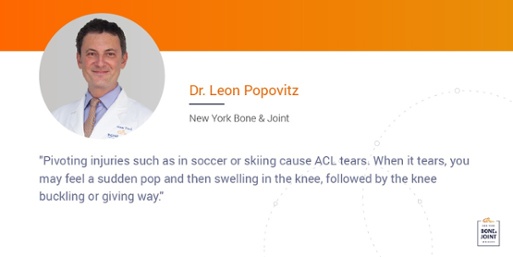
Can You Tear Your ACL Without Knowing?
It’s possible if the tear is mild, so you may not feel any symptoms right away. Because your knee has three other ligaments to stabilize it, you may be able to walk or limp with mild ACL damage. It’s not recommended you do so for an extended time. Symptoms of a complete tear are significant and hard to ignore.
How Do You Tear Your ACL? Common Causes and Risk Factors
Several risk factors increase your odds of an ACL tear.
- Sports. Sports involving jumping, landing, and abrupt pivoting (basketball, soccer, football).
- Contact vs. non-contact. Hard hits to the knee in football can injure the ACL. But non-contact tears can occur, such as in a car accident or stepping awkwardly off the curb.
- Gender. Women stand a greater chance of an ACL tear due to their anatomy and hormones.
- Return to activity too soon. Resuming sports or strenuous activities before a full recovery from a tear increases the chance of re-injury.
- Not wearing proper equipment. Failing to wear the proper protective equipment, such as a knee brace, during sporting activities can leave the ACL vulnerable to a tear.
ACL Tear Recovery Time: What to Expect
Unfortunately, ACL tears do not heal on their own. For a complete tear, you’ll likely require an ACL arthroscopy surgery to repair or replace the damaged ligament. However, for older, less active individuals, conservative therapy can restore function to the knee and reduce pain.
ACL tear recovery times depend on the activity level of the patient and severity of the tear.
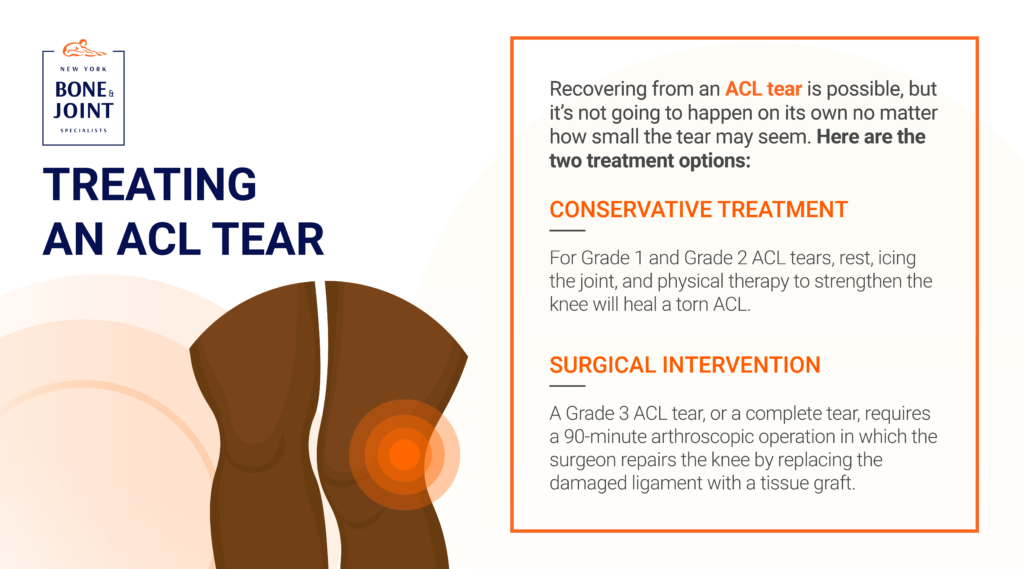
Non-surgical recovery. Rest, anti-inflammatory medications, and physical therapy to increase range of motion in the knee are conservative options. Physical therapy can take up to eight to 10 weeks. You’ll wear a knee brace and may use crutches to keep the knee stable as you participate in physical therapy.
Surgical recovery. ACL tear reconstruction requires at least nine months of rehabilitation that consists of using crutches and a brace for the first weeks after surgery. Physical therapy will gradually strengthen the muscles (quads and hamstrings) surrounding the knee. Stretching exercises will also improve the knee’s flexibility. Professional athletes may need a year to fully recover.
ACL Tear Knee Braces: Support and Protection Options
An important element of ACL tear recovery is wearing an ACL tear brace. Designed specifically for an ACL tear, the brace provides an external support structure for the knee as you rehabilitate the joint. It limits how much you can move the knee so you don’t further aggravate the injury.
Work with your surgeon and physical therapist to select appropriate bracing based on:
- Activity demands and return-to-sport goals
- Knee stability and healing progress
- Comfort and compliance factors
- Budget considerations
Braces are available in a variety of forms.
Custom made vs. off the shelf. Custom-made braces fit the exact structure of your knee and leg, providing extra support and stability. Off-the-shelf versions stabilize the knee in a more affordable option. Which you choose depends on the severity of the ACL tear and your activity level.
Functional vs. prophylactic. Functional knee braces support the injured knee during rehabilitation and recovery. Prophylactic braces protect the knees from tears when playing contact sports.
When to wear a brace. Bracing is recommended for most individuals, especially those involved in high-intensity sports, post-surgery.
- First 2 to 6 weeks. The brace will lock your knee in place while walking. You can take it off while resting, but must keep it on when sleeping or bearing weight on the knee.
- After 6 weeks: Transition to a functional brace, which will be worn until you’ve regained quad strength.
Weight-bearing precautions: After surgery, you’ll use crutches with the brace to maintain a straight leg. At the first post-op visit within 10 to 14 days, your doctor will assess how much weight you can put on the knee.
Why choose us for ACL tear surgery in NYC?
New Yorkers have trusted our ACL tear doctors and surgeons for decades. We are recognized as leaders in the field due to our:
- Commitment to Joint Health: We prioritize the health and healing of your joints, understanding their vital role in an active and fulfilling life.
- Comprehensive & Compassionate Care: Our world-class specialists provide expert, empathetic guidance from diagnosis through rehabilitation.
- Effective Non-Surgical Solutions: Over 90% of ACL tear cases are successfully resolved through our orthopedic treatments, often avoiding surgery.
- Dedication to Your Full Recovery: We are committed to your complete recovery, utilizing conservative methods and only resorting to expert surgical intervention when absolutely necessary.
NYC’s Top-Rated ACL Tear Specialists
At New York Bone & Joint Specialists, our philosophy centers on preserving your body’s natural structures, particularly for long-term knee health. This commitment to exceptional care means 90% of our patients recover without surgery, ensuring lasting health and function, and offering peace of mind.
Make an appointment today
Ready to take the first step toward relief? Schedule an appointment with New York Bone & Joint Specialists and start your personalized recovery plan today.
Frequently Asked Questions
What are the early signs of an ACL tear?
The most common early signs include a loud popping sound during injury, immediate severe pain, rapid knee swelling within hours, and a feeling that the knee is unstable or “giving way.” Even mild symptoms require immediate medical evaluation.
How long does it take to recover from an ACL tear?
Recovery time depends on treatment approach and individual factors. Non-surgical treatment may provide improvement in 8-12 weeks, while ACL reconstruction recovery typically takes 6-12 months for full return to sports. Professional athletes often require 9-12 months for competition-level return.
Do I need surgery for every ACL tear?
Not necessarily. Partial tears in less active individuals may respond to conservative treatment. However, complete ACL tears in athletes and active individuals typically require surgical reconstruction for optimal function and stability. Your surgeon will recommend the best approach based on your activity level, age, and goals.
What’s the best knee brace for a torn ACL?
The best brace depends on your activity level and stage of recovery. Active individuals typically benefit from custom-fitted hinged braces that provide maximum support while allowing controlled movement. Your surgeon and physical therapist will recommend the most appropriate option for your specific situation.
How do I find the best ACL doctor in New York?
Look for board-certified orthopedic surgeons with fellowship training in sports medicine or knee surgery. At New York Bone & Joint Specialists, our ACL specialists have extensive experience with all modern reconstruction techniques and focus specifically on returning athletes to peak performance.
Can I prevent ACL tears?
While not all ACL tears can be prevented, research shows that neuromuscular training programs can reduce injury risk by up to 50%. These programs focus on proper landing technique, strength training, and balance exercises. Female athletes particularly benefit from ACL injury prevention programs.
What happens if I don’t treat my ACL tear?
Untreated complete ACL tears lead to chronic knee instability, increased risk of meniscus tears and cartilage damage, and early-onset arthritis. Even with activity modification, long-term knee problems are likely without proper treatment.
